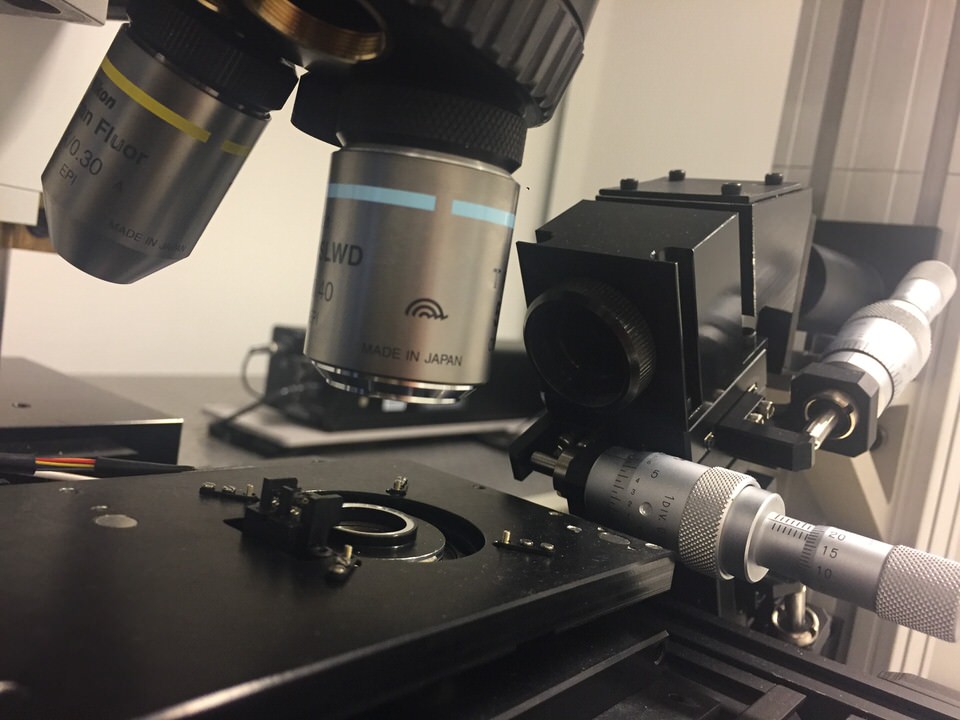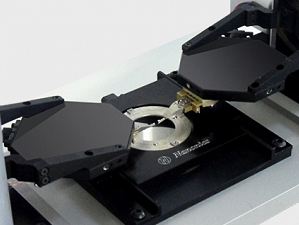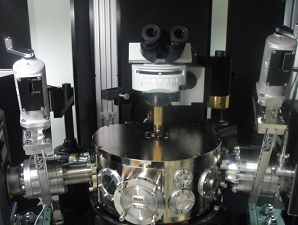The Fountain Pen Nanolithography (FPN) MultiProbe system is an SPM platform capable of both chemical nanolithography and online imaging with multiple probes. Based on our revolutionary multiprobe technology, this system provides two completely independent SPM probes. Thus one probe can write using two different materials, or one probe “writes” while the other probe "reads" or images the deposition with a high resolution AFM probe without moving the sample or exchanging the probe. The MultiProbe system has a modular design and can be upgraded to four SPM probes. Different methods are used for nanometric control of the delivered and deposited material including capillary action, force control and capillary electrophoresis.
FPN systems allow for unique online integrations with a variety of instruments such as optical microscopes, Raman spectroscopy, confocal microscopes, etc. Furthermore, it uses Nanonics NanoToolKitTM probes for a variety of SPM functional imaging techniques.

Key Features
Wide Range of Inks and Surfaces
- Total flexibility for your experiments
- A variety of inks including organic liquids, aqueous liquids, gases, proteins, nanotubes, nanoparticles and rods
- A variety of surfaces and samples including any geometry - flat or rough, and any material - conducting or insulating. Also suitable for deposition onto large samples such as wafers, petri dishes and microscope slides
Comprehensive Characterization
- Full characterization of your deposited/written features
- Multiple probe lithography protocols for reading, writing and simultaneous imaging on one platform
- Free optical axis allowing full integration with optical microscopes for optical and spectroscopic analysis including fluorescence, Raman, and near-field optics.
- Full operation inside environmental chambers and flexible connection with chromatography systems.
- Online SPM characterization of written features including Electrical, Thermal Conductivity, Magnetic , optical near-field (NSOM) and far-field characterization operation
Precision
- Precise placement of liquid or gas within nanometers of accuracy
- Electrophoretic lithography of gases via electrical pulses for accurate and controlled chemical deposition
- Pressure controlled deposition of liquids
Unique FPN Technology


Levi Gheber
Ben Gurion University
Applications
Filling Si Trench with Au Particles
Problems with a complicated surface structure, such as a circuit edit, can be addressed only by Fountain Pen Nanolithography. It has a Z-range of >100 microns, allowing the AFM to see deeper into trenches than any other system can.

10 x 10 micron AFM image of a 10 micron deep/2 micron wide trench

Controlled filling of silicon trench with gold particles: before and after
Au NanoParticle Lines Printed on a Microchip

SEM and AFM gold nanoparticles line printed on semiconductor surface. (a) SEM image shows the gold nanoparticles line printed by FPN. Scale bar is 5 microns. (b) AFM image of smaller area than in (a) shows the same printed line as in (a).
Ink Jet Protein Printing

A: Confocal image of deposited Bovine Serum Albumin (BSA) protein deposited with 150nm AFM nanopipette probe with a driving pulsed voltage at the sequence shown in B. The image shows deposition of the protein at the negative provided pulses. Bar is 6 microns.
B: Diagrammatic spatial map of the provided voltage applied on the Nanopipette at a negative pulsed signal as shown in C.
C: Negative pulses voltage provided through two electrodes at the inner of the nanopipette and the metallic coating at the end of the nanopipette’s tip. The image (A) shows clearly that the protein was delivered out to the surface at the blue lines where the voltage is -1V and no writing at the zero voltage areas indicated by green at B.
Featured Paper: “Atomic-force-controlled capillary electrophoretic nanoprinting of proteins. ”
Authors: Lovsky Y, Lewis A, Sukenik C, Grushka E.
Refernce: Anal Bioanal Chem. 2010 Jan;396(1):133-8.
Etching of Chrome Film with Free Chlorine Radical
 Protein printing is made possible by the Nanonics Chemical Delivery System and Nanopipette Only Nanonics can deliver chemicals or gas onto the sample on line, with no need to remove the tip from the sample. Seen in image:
Protein printing is made possible by the Nanonics Chemical Delivery System and Nanopipette Only Nanonics can deliver chemicals or gas onto the sample on line, with no need to remove the tip from the sample. Seen in image:
Contact a Nanonics Specialist to Discuss Your Specific Needs
We are happy to answer all questions and inquiries
Images
Videos
Drawing Single Walled Carbon Nanotubes on Si02
Drawing Single Walled CNT Electrode Interconnections
Nanolithography with Online AFM Imaging
Deposition of Protein Nanoarray
Writing of a Protein
Deposition of Ultra-thin BSA Protein Lines on Si Surface
Filling & Preparing the NanoPipette Probe
Configurations
Which Nanonics system configuration is right for your Nanolithography research?
Publications
Read exemplary, peer-reviewed literature on studies using Nanonics Nanolithography systems
| Micrometer to 15 nm Printing of Metallic Inks with Fountain Pen Nanolithography |
| Yeshua, T., Layani, M., Dekhter, R., Huebner, U., Magdassi, S., & Lewis, A. |
| Small 14(1) (2018) |
| The evolution of fountain pen nanolithography: Controlled multi-probe delivery of liquids and gases. |
| Yeshua, T., Weinberger, S., Taha, H., Lewis, A., Layani, M., Magdassi, S., ... & Dekhter, R |
| Microscopy and Analysis 28, S11-S13. |
| High-Precision Automated Micromanipulation and Adhesive Microbonding with Cantilevered Micropipette Probes in Dynamic Probing Mode. |
| Xie, H., Zhang, H., Song, J., Meng, X., Wen, Y., & Sun, L. |
| IEEE/ASME Transactions on Mechatronics. (2018) |
| Scanning probe microscope-based fluid dispensing. |
| Ghatkesar, M. K., Garza, H. H. P., Heuck, F., & Staufer, U. |
| Micromachines 5(4), 954-1001. |




